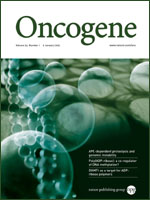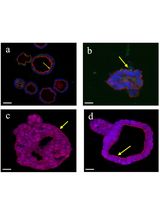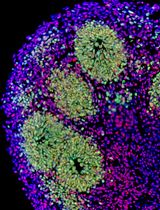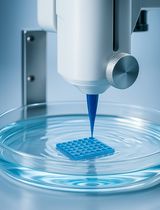- 提交稿件
- 订阅
- CN
- EN - English
- CN - 中文
- EN - English
- CN - 中文
Longitudinal Bioluminescent Quantification of Three Dimensional Cell Growth
利用生物发光技术持续定量监测细胞的三维生长
发布: 2013年12月05日第3卷第23期 DOI: 10.21769/BioProtoc.993 浏览次数: 9004
评审: Lin Fang
Abstract
The use of three-dimensional (3D) cell culture systems is widely accepted as representing a more physiologically relevant means to propagate mammary epithelial and breast cancer cells. However, 3D cultures systems are plagued by several experimental and technical limitations as compared to their traditional 2D counterparts. For instance, quantifying the growth of mammary epithelial or breast cancer organoids longitudinally is particularly troublesome using standard [3H]thymidine or MTT assay systems, or using computer-assisted area calculations. Likewise, the nature of the multicellular aggregates and organoids formed by breast cancer cells under 3D conditions precludes efficient recovery of the cells from 3D matrices, an event that is time consuming and leads to spurious results. The assay described here utilizes stable expression of firefly luciferase as means to quantify the longitudinal outgrowth of cells propagated within a 3D matrices. The major advantages of this technique include its high-throughput nature and ability to longitudinally track single wells over a defined period of time, thereby decreasing the costs associated with assay performance. Finally, this technique can be readily combined with drug treatments and/or genetic manipulations to assay their effects on the growth of 3D organoids.
Materials and Reagents
- Murine 4T1 mammary carcinoma cells (ATCC, catalog number: CRL-2539 ) or any cell line of interest engineered to stably express firefly luciferase under the control of a constitutively-active promoter such cytomegalovirus.
Note: Several Luciferase encoding plasmids are commercially available and typically employ pcDNA3.1- or pBabe-based backbones to deliver firefly or renilla luciferases. In either scenario, antibiotic administration is used to select and maintain stable expression of luciferase in reporter cells.
- Cultrex: Reduced growth factor (RGF) basement membrane extract (BME) (Trevigen, catalog number: 3433-005-01 )
- Ice
- Dulbecco’s Modified Eagle Medium (DMEM) (Life Technologies, catalog number: 10313-021 )
- Penicillin/Streptomycin (Pen/Strep) (Gibco®, catalog number: 15140 )
- Fetal bovine serum (Sigma-Aldrich, catalog number: F1051 )
- D-luciferin, Potassium Salt (15 mg/ml) in sterile H2O (Gold Bio, catalog number: LUCK-1G )
Equipment
- 2D culture dishes
- White walled, clear bottom 96-well culture dishes (Corning, Costar®, catalog number: 3610 )
- Luminometer capable of reading 96-well plate format (Promega GloMax-Multi Detection System or similar bioluminescent plate reader).
- Hemocytometer or other means of cell counting
- 37 °C/5% CO2 cell incubator
Procedure
文章信息
版权信息
© 2013 The Authors; exclusive licensee Bio-protocol LLC.
如何引用
Wendt, M. K. and Schiemann, W. P. (2013). Longitudinal Bioluminescent Quantification of Three Dimensional Cell Growth. Bio-protocol 3(23): e993. DOI: 10.21769/BioProtoc.993.
分类
癌症生物学 > 通用技术 > 细胞生物学试验
细胞生物学 > 细胞分离和培养 > 3D细胞培养
您对这篇实验方法有问题吗?
在此处发布您的问题,我们将邀请本文作者来回答。同时,我们会将您的问题发布到Bio-protocol Exchange,以便寻求社区成员的帮助。
提问指南
+ 问题描述
写下详细的问题描述,包括所有有助于他人回答您问题的信息(例如实验过程、条件和相关图像等)。
Share
Bluesky
X
Copy link














